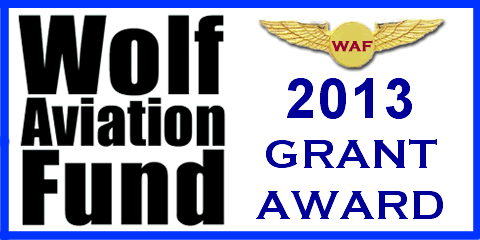CYAP is proud to be supported by:
Aviation Educational Contests
-
Real World Design Challenge – High School students work on real world aviation problems. Participating schools and organizations receive $1 Million worth of FREE engineering and scientific software. http://www.realworlddesignchallenge.org/
-
International Aviation Art Contest - Challenges youth to illustrate the importance of aviation through art. Demonstrating the impact of aeronautics through an interactive, fun medium such as art motivates youth of all ages to become more familiar with aeronautics, engineering and science. The contest is open to youth between the ages of 6 and 17 where they compete in one of three age groups and are judged on their creative use of the theme in relation to the aviation world. The subject of the contest is announced in September of each year and the entries must be submitted by mid-January. http://www.nasao.org/TEST/Center/InternationalAviationArtContest.aspx
-
CyberPatriot National Youth Cyber Education Program - Inspires high school students toward careers in cybersecurity or other science, technology, engineering, and mathematics (STEM) disciplines critical to our nation's future. The National Youth Cyber Defense Competition, which challenges teams of students to resolve real-life cybersecurity situations in a virtual environment. https://www.uscyberpatriot.org/
-
Team America Rocketry Challenge - Teams made up of 3 to 10 students -- design, build and launch rockets to meet rigorous performance specifications. The rockets must reach a target altitude of 825 feet and return to the ground from a flight of 48 to 50 seconds in duration with a payload of two raw eggs intact. Scoring is based on how closely the rocket meets the altitude and flight duration targets. http://rocketcontest.org/
-
US Secretary of Transportation, RAISE Award - The competition called the Secretary’s Recognizing Aviation & Aerospace Innovation in Science and Engineering (RAISE) award – spurs students at high schools and universities to think creatively by developing innovative solutions to real-world aviation and aerospace challenges, and to share those innovations with the broader community. The award winners are those who demonstrate outstanding and unique scientific and engineering innovations. The submission period for this competition is April 1, 2014, to Dec 30, 2014. http://www.dot.gov/office-policy/aviation-policy/secretary-transportations-raise-award
-
The Conrad Challenge is open to high school students. It includes four areas aviation & space, Cyber-Technology & Security, energy and environment, health and Leap to Mars. Registration closes for the 2015 contest on November 3, 2014.https://conradchallenge.squarespace.com/registration/.
-
Fly to Learn - Students of all ages learn science, technology, engineering and math (S.T.E.M) through designing, building, and flying their own virtual airplanes. The software, including curricula and training, costs less than a few dollars per student annually. This is the program that I told you about where 2 teams won a free trip to the Glasair Aviation facilities in Arlington, Washington. Students built a Sportsman 2+2 aircraft from June 17th through June 29th, 2013, after which the aircraft were professionally test flown and displayed at this year’s AirVenture 2013 in Oshkosh, Wisconsin. (http://www.flytolearn.com/)
Aviation Education Resources
-
National Coalition for Aviation and Space Education (NCASE) http://www.aviationeducation.org/index.htm#. If you click on the section labeled NCASE Guide in the lower left column of the webpage, it will pop up a directory of aviation educational programs.
-
Federal Aviation Administration (FAA) http://www.faa.gov/education/
-
National Aeronautics and Space Administration (NASA) (http://www.nasa.gov/audience/foreducators/) websites list educational programs.
-
Civil Air Patrol - 'Making Aerospace Real for Students' (MARS) program offers:
-
All types of free national standards-driven K-12 aerospace/STEM education materials (for homeschoolers, too)
-
Awards, such as AEX, for schools that adopt aerospace education into their curricula
-
Grants available from Air Force Association to incorporate aerospace/STEM into the classroom
-
Orientation flights in powered aircraft
-
Aerospace-oriented summer workshops in conjunction with the Air Force Association and other educational organizations
-
Aerospace/STEM education speakers and resources nationwide
-
More information can be found at http://www.gocivilairpatrol.com/cap_home/educators/
-
-
Smithsonian Air & Space Museum offers the following virtual interactive tours for young people
-
To The Moon and Beyond is best for middle and high school age students. This program is conducted by a team of three volunteer docents
-
Kites, Wings, and Flying Things program is best for elementary age students and is available on Tuesdays. It is approximately one half hour in length. This program is conducted by a staff member from our Education Division.
-
More information about the Smithsonian Interactive Visual Con programming can be found at (http://airandspace.si.edu/explore-and-learn/educator-resources/videoconferencing.cfm) which also contains a link to an online request form. The Smithsonian uses Vidyo software for their tours (if a site does not have dedicated videoconference equipment) which can accommodate up to 100 locations at a time. Most of the programs are made to be interactive so having a microphone and webcam for return audio and video is preferred.
-
-
Think Global Flight – Students of all ages in teams follow a teacher as she and her copilot fly around the world. The students will help plot courses and will also research and answer STEM based questions. The round the world flight will start in May 2014. www.thinkglobalflight.org


